
Digital Imaging Today & How digital cameras work. 💻🤍📸
The art of imagery has come a long way since the first photograph was taken in 1814. Back then, cameras were considered a rare item and most people resorted to painting family portraits or cutting out black and white silhouettes of themselves as memorabilia.
Fast forward to today, and it's easy to see how times have changed. Image capturing devices of all shapes and sizes are now a ubiquitous as any other gadget, especially considering that they can now come as a built-in feature in other easily pocketable devices It also helps that through the digital format, a more carefree culture of photo-taking is encouraged --that is, photographers, experienced or otherwise, can now take hundreds of pictures at any given time compared to what a 36-shot roll of film can allow.
The camera industry has grown into a versatile market, now offering a diverse range of models to cater to the needs of users of varying levels of experience --from beginner, to mid-range, to professionals. Let's kick things off with a crash course in the types of tools of the trade for the modern digital photographer.
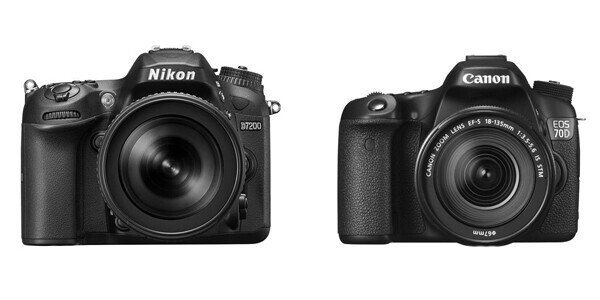
DSLR Cameras.
The DSLR (digital single-lens reflex) camera is often equated with professional photography due to its signature look --a predominantly black color scheme and the bulk reminiscent of classic 35mm format film cameras of old. By definition, DLSR cameras use mirrors and pentaprisms within the device, working in tandem with an image sensor and shutter mechanism to capture images.
Aside from the disparities in size and bulk, interchangeable lens systems, compact digital cameras mostly come with fixed lenses. Inside, the image sensors fixed into DSLR systems also have larger surface areas compared to their generic compact counterparts. Broadly speaking, larger sensors equate The versatility offered by a diverse range of lens options addressing varying shooting styles, along with the generally larger sensor sizes that comes with DSLR cameras., Make DSLRs the de facto camera-of-choice for professional still photographers.
These days, however, DSLR camera models are not exclusively a professional photographer's device. More and more models are being developed to cater to entry-level market, featuring lots of compact camera styled presets modes, and even video recording, enabling any consumer with a keen interest in the digital image, as well as the financial capacity to invest, to harness such advanced imaging equipment.

Compact Cameras.
Compact digital cameras, also commonly referred to as point-and-shoot cameras, are generally those offer the user-friendly functionality in a form that is compact enough to fit into a pocket. Despite these glaring and almost polarized differences from DSLR cameras, compact cameras have long boasted capacities for high resolution image capture, although arguably not as refined as that of DSLRs.
Most compact cameras are equipped with retractable lenses which provide some degree of zoom focus, as well as safekeeping for when the camera is not in use. Standard compact cameras also forgo the optical viewfinder with an electronic one, allowing users to compose and preview their shoots In addition, these types of cameras also have pre-programmed shooting modes for several common photographic opportunities, as well as for creative photography, allowing users to just set a dial and shoot away to their heart's content. Video recording is also a standard feature.
There are several sub-categories for compact cameras, covering the likes of super-zoom, all weather, utra-slim form factor models. And more. In fact, particularly some DSLR cameras are being "watered-down" for a less-experienced user base, there are compact cameras built for more advanced users ("prosumers") who are looking for a more portable shooting tool, or perhaps a back up camera. Compacts such as these feature manual controls as well as internal hardware comparable to those found in DSLRs.
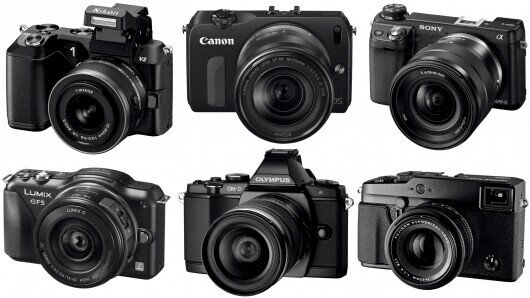
Mirrorless Interchangeable Lens Camera
Taking the space ones blurred by prosumer compact cameras and entry level DSLR models, the Mirrorless Interchangeable Lens Camera (MILC) first debuted in 2008 in the form of Micro Four Thirds (MFT) system, which is essentially an extension of Four Thirds system, an emerging new standard that allows for the interchangeable of lenses across different digital system camera manufacturers.

The MILC specializes in reducing the size and weight of the cameras and lenses, while maintaining the integrity of the photo with MILCs generally fitted with a DSLR-size sensor housed in a more compact and lighter body, this type of camera effectively offers the best of both compact and DSLR worlds. The key difference between a DSLR camera and an MILC is that the latter has no internal mirror mechanism to speak of.
MILC technology was first developed due to certain integrity issues from DSLR cameras, such as resolution loss and chromatic aberration. The DSLR also has a tendency of developing less-than-sharp images, ghosts, and flares when the light reflected onto the image sensor is then reflected again on the lens surface.
On the flip side, DSLR cameras still maintain the upper hand over MILCs in terms of the range of compatible accesories, as well as more mature selection of lenses. Also, from a price point perspective, many MILC offerings range around the entry-level DSLR range (sometimes even higher), so they may not be as appealing to the budget conscious photography newbies compared to more recognizable DSLR cameras.
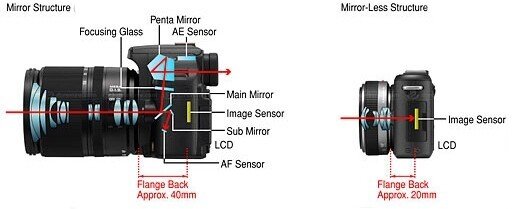
These cutaway views of a DSLR (left) and an MILC (right)
camera illustrates the structural differences between the two types of cameras. ^ _ ^
-------------------------------------------------- ----------------------------------
HOW A DIGITAL CAMERA WORKS

Knowing how a digital camera works gives you a greater understanding of its strength and weaknesses, and thus, how to use it. It can also guide you to make more informed purchases.

All cameras work by using a lens to focus light coming from a scenario onto a light-sensitive image sensor. Digital cameras are designed very similarly to film cameras, but there are some fundamental differences.
Instead of film, digital cameras use digital sensors and memory to capture and record images. The LCD monitor on a digital camera gives a photographer the advantage of previewing images immediately, without the delay of developing films. While a physical shutter is used in a film. camera, an electronic one is used in most digital compact cameras, and DSLRs may use a combination of both.

The Image Capture Process
Step 1:
When the camera's sensor is ready to shoot a picture, it is at a "reset" position in the darkness of the camera's body with no electrical charge.

This is 4x4 pixel section of a standard digital camera image sensor. Each square represents a single photosite and corresponding pixel. Each photosite has either a red, blue, or green color filter overlaid on it (in a Bayer pattern) to interpret color.
Step 2:
When the shutter button is pressed, the shutter turns on or opens for a preset period of time, and light from the scene passes through the camera's lens before finally hitting the image sensor.

Step 3:
Each photosite on the sensor measure the light photons hitting it and generates an electrical charge that registers the intensity of the light that is being captured. Depending on the intensity of the light and resultant charge, each photoite is assigned a black, white The black "0" value is calibrated by the bordering photosites that are not used in image sensing.

Step 4:
After the charge for each pixel has been registered and its color defined by RGB values, an analog to digital converter (ADC) "reads" every pixel and converts the information into binary format for storage.

Step 5:
To add color to the image, each pixel needs to define the specific color of the light photon hitting it by identifying it with a combination of values for red, green, and blue colors. As each pixel can only sense a single color , it derives the values for the missing two colors by sampling, then averaging the color values from the closest surrounding pixels with surrounding color filters.

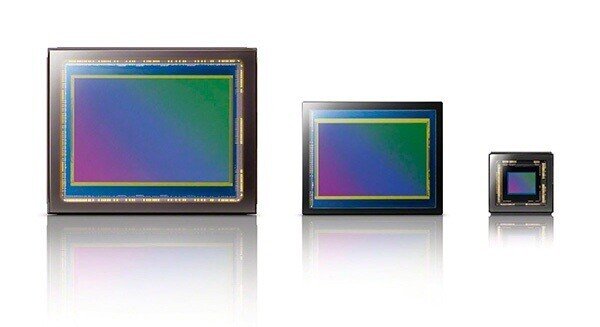
How do image sensors work?
Developed on the same premise as traditional film, digital image sensors are designed to absorb light rays. Once the intensity and color of light has been recorded, the information is converted into an electrical signal, which in turn is then used to create an instant digital image.

What are they made from?
An image sensor is primarily made up of three layers, all of which play an important role in recording light that in turn produces an image. The top layer of an image sensor is most commonly made from silicon, a material that absorbs light well. Beneath These also help the sensor to determine the intensity of this layer is a small microlens, which directs light down accurately onto each pixel location. The light (highlights and shadows) and record color.
What is a pixel?
Your camera's sensor is made up of millions of pixels; each one is responsible for a select area in your digital image. The amount of pixels the sensor has determines how many megapixels your camera offers. The more megapixels, the higher your image resolution.
How do they capture light and color?
An image sensor is monochrome. It can detect the intensity of light, but not color. The filter makes each pixel responsive to one primary color of either Red, Green or Blue (RGB). These colored operators are laid out in rows fitting a pattern. That alternates between red and green in one The camera then uses a process called color interpolation to ensure your image has all the right hues and tones. The camera then uses a process called color interpolation to ensure your image has all the right hues and tones.

Sensor sizes
Camera manufacturers are often boasting about their camera's high megapixel counts, which can mislead consumers into the thinking that the more megapixels a camera offers, the better the image results will be. In fact, in order to get great shots, there needs to unless your sensor is large enough to accommodate all the pixels comfortably, the resulting image quality will be no better than if you were to shoot with a low-megapixel camera. To ensure your camera has the potential to shoot great-quality captures, look into how many pixels your sensor offers in relation to it size. For example, an APS-C size image sensor that is around 23.6 x 15.7mm will produce much better quality images if it offered just 14 megapixels as opposed to 22 megapixels. This is due to the fact that larger pixels can record more light and detail, which will result in better-quality captures.
Full frame sensor (35mm) – High-end professional DSLR cameras offer what is commonly known as a full-frame sensor, which is the same size as 35mm film.
APS-C sensor (23.6mm x 15.7mm) – Most mid-range and entry-level DSLRs and CSCs offer APS-C- sized image sensors, based on the size of traditional APS-C film.
7.5mm x 5.7mm sensor -Commonly Found In Compact Cameras, The Smaller Sensor Size Can Still Produce Great Shots Providing There Are Not Too Many Megapixels Present.

Types of sensor
Along with different sizes, there are two main types of image sensor, CMOS and CCD. Both are designed to turn light into electronic signals so that the camera can produce a digital image. However, it's the way in which the sensors do This that makes. . they differ.
CCD – In a CCD (Charged Couple Device) sensor, each pixel will capture light then move the recorded information along to the edges of the sensor to get converted into electrical signals. Produce a digital image. Although accurate, this conversion process requires a lot This is much more efficient, less expensive and requires a lot less power,of battery power.
CMOS --By comparison, a CMOS (Complementary Metal Oxide Semiconductor) sensor will automatically convert light into an electrical signal as soon as it reaches a pixel. making them a popular choice.
Live Mos -. Camera Manufacturers Such As Leica, Panasonic And Olympus Are Known For Using An Entirely Different Type Of Sensor, Live Mos This Sensor Is Considered A Bridge Between A CMOS And CCD As Image Quality Is Said To Be On A Par With A CCD but with the efficiency of a CMOS.

FOV Crops.
Digital sensors are typically smaller than the 36 x 24mm surfaces of one frame of film, so if you use the same lens to shoot the same scene with two different media, the photo captured by the sensor will be cropped as it won't be to As Wide An Cover Area As The Frame Of The Film.
This Is A Cropped Field Of View (FOV)
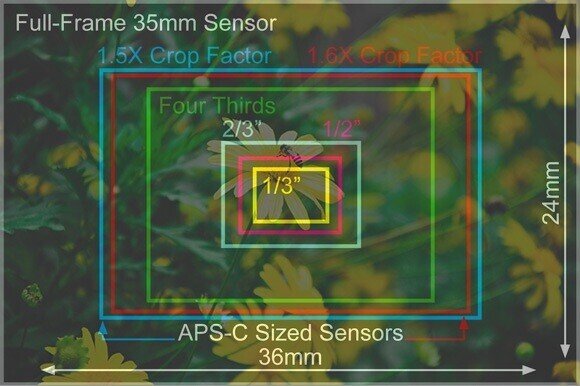
Because of this "35mm film equivalent" is a measurement created to refer to focal lengths of digital cameras that have sensors smaller than the size of traditional film. This measurement, though not always perfectly accurate, will give you an idea of how lenses perform on different digital cameras. Sensor sizes vary great; y, from the tiny ones of found in mobile phones to the "full-frame" (no fov crop) one seen in pro DSLRs.
How Much Resolution Do You Really Need?

Do higher megapixel counts make for better images?
The honest answer is NO.
Infact, a 3-megapixel camera captures photos already good enough for A4-sized prints. Higher resolutions are only necessary if you crop your photos or print at large sizes, because It lets you capture more detail. Increasing image resolution on a too-small noise in pictures, so while higher resolutions can be good, more is not always better, depending on the camera in question.
Digital Zoom And Interpolation
A camera's digital zoom uses a processing technique called interpolation to crop and magnify objects in the frame. In other words, it only simulates the effects of zooming in, as opposed to optical zooming, which actually uses the lens to zoom in and out of a subject.
Interpolation works by spreading the pixels of the cropped area further apart, then sampling them to artificially fill in the surrounding void with what the camera thinks should be there. That's why photos magnified with digital zoom are less detailed than those magnified using an optical zoom. If you're particular about your camera's zoom capabilities, do note that certain models available today are engineered specifically to suit this need, coming with long-range optical zoom ranges up to 30x and higher!

This series of pictures illustrates the effects of using optical and digital zoom on a Canon Powershot S95. The first image is shot at no zoom, the second with the maximum 3.8x optical zoom, and the last with digital zoom at 15x. In the last photo, the camera merely crops the portion out from the image and interpolates it to the new size, resulting in slight degradation of quality.
I hope you enjoy reading the first and second part of digital photography basics. :)
--juley
この記事が気に入ったらサポートをしてみませんか?
